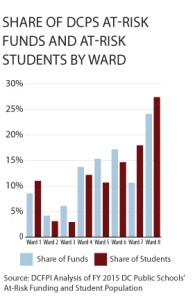Some DC Public Schools with large numbers of low-income students didn’t receive their share of funds for “at risk” students this year, while some schools with lower levels of need saw more than their share, a new data tool shows. While this was the first year for at-risk funding and there wasn’t much time for DCPS to strategically apply these funds within the tight budget timeline, we should make sure next year that schools in need see their fair share of resources intended to help low-income students.
DCFPI and Code for DC teamed up to show how the over $40 million in DCPS’ at-risk funding — which is designed to give extra attention to children struggling in school or at risk of academic failure — matched the number of students eligible for the funding at each DCPS school this year. You can click on a school to see more detailed information on its at-risk student population. It also shows at-risk funding received per student, compared with the amount of funds the school should have gotten through the formula if funding had followed the student, as DC law requires. In addition, you can see what purposes the at-risk funds were used for, according to DCPS.
DC’s school formula was adjusted substantially this year to better reflect what DC students need to succeed. Increases were provided for special education, English language learners, and an entirely new category for low-income or “at risk” students was created. Over 30,000 students in DC Public Schools and public charter schools are considered at-risk. As of the 2014-15 school year, the school funding formula provides $2,079 additional dollars to help meet the needs of these students.
According to DC law, at-risk funding is supposed to follow the child to every DCPS school and school leaders are to have flexibility in how they use these resources. But, due to time constraints in the budgeting process, this was not possible in this first year. The funding went to a number of DCPS initiatives that were already planned, but were not necessarily targeted to improving the performance of at-risk students.
Here are a few highlights:
- Wards 1, 7, and 8 saw less at-risk funding than if funding had followed students. For example, Ward 7 schools have 18 percent of the city’s at-risk students, but only got 11 percent of the at-risk funding. (See the figure below.)

- Most of the at-risk funds went toward middle grades staffing, extending the school day, and grants to schools to promote “student satisfaction,” such as field trips or anti-bullying efforts. These are great ideas for programs, particularly the social and emotional supports like guidance counselors and special education teachers, but as a result of that focus some high-need schools got less than their share of increases. In the case of the student satisfaction grants — 12 percent of the at-risk funds allocated — all DCPS schools received that money, and there was no specific tie to at-risk population.
- DC law also requires that schools cannot lose more than 5 percent of their budget from year to year. In the current school year, a small share of the at-risk money was used to meet this requirement. It is unclear if there will be sufficient funding to meet this requirement next year if the formula does not increase but DCPS wants to continue last year’s investments in middle grades while also investing in new priorities.
DCPS has said that investments in high schools are a priority for next year. DCFPI thinks this is long overdue, but is concerned that at-risk funding will once again not be allocated proportionally to high-need schools within the system.
You can check out the tool here: http://atriskfunds.ourdcschools.org
To print a copy of today’s blog, click here.
